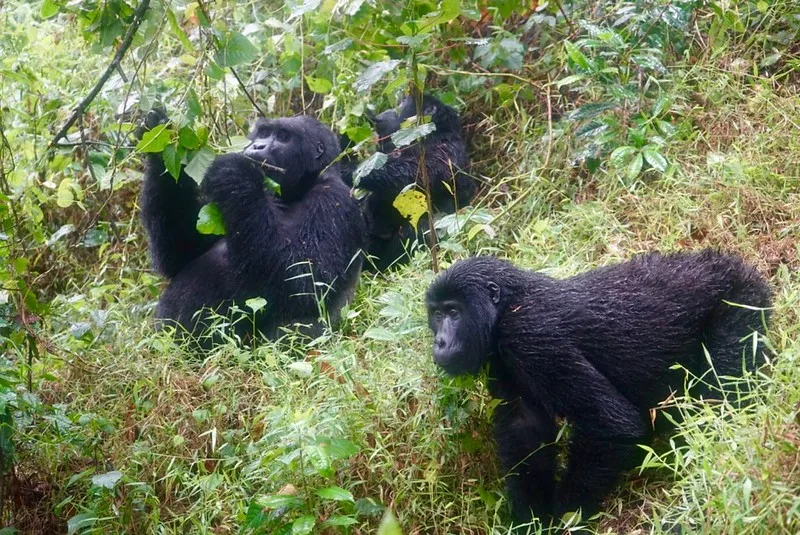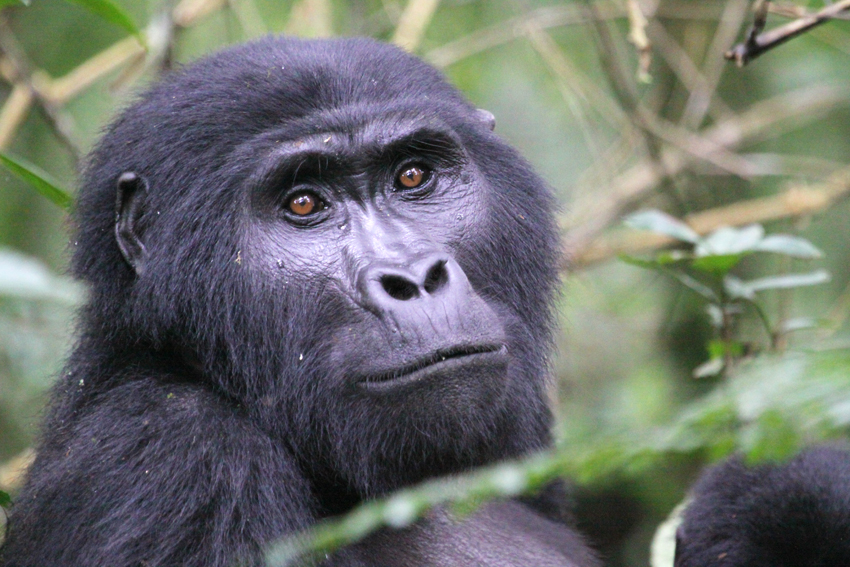Why Mountain Gorillas are Visited Once And For One Hour.
Only one hour is allowed to spend time with gorillas during gorilla trekking, and each country where they reside allows one visit per day. Only three African nations—Rwanda (Volcanoes National Park), Uganda (Bwindi Impenetrable National Park), Mgahinga National Park, and the Democratic Republic of the Congo (Virunga National Park)—are home to mountain gorillas.
According to a census conducted by American philanthropist Dian Fossey in the 1980s, there were around 300 mountain gorillas in the world. Numerous variables, including human involvement, like as poaching and snare-setting, were blamed for this. She devoted her life to ensuring the mountain gorillas’ survival, even establishing the Karisoke study Center in Rwanda as a gorilla study facility.
Her realization that people needed to get closer to gorillas for them to live led to the creation of gorilla habituation and, subsequently, gorilla trekking. The goal was to acclimate both humans and mountain gorillas to one another without changing the primates’ inherent characteristics. More money is raised by gorilla trekking to help with mountain gorilla conservation efforts.
Given the limited history of gorilla trekking mentioned above, regulations were established to encourage this activity that spanned across all mountain gorilla areas. One of the most important gorilla trekking guidelines is to just spend an hour with the gorillas. This is the reason Mountain Gorillas are accustomed to spending an hour with people.
The mountain gorillas are educated to spend just one hour with humans throughout the gorilla habituation procedure. The act of acclimating wild mountain gorillas to human presence without changing their natural behavior is known as “gorilla habituation.”
Because these giants are naturally timid and have dark brown eyes, this procedure helps animals become used to people. You just have an hour with them, therefore you don’t need to look them in the eyes because it makes them timid and can make them hide. To enable Mountain gorillas to gather food
Gorillas are naturally vegetarians. Their main food is bamboo, which is often found on highland slopes between 2400 and 3000 meters above sea level. They only eat leaves. Among other things, they consume soft stems, leaves, and fruits. To sustain the gorillas’ enormous bulk during the day and night, they must be collected all day.
Gorillas may consume more than 300 pounds of vegetation every day. Although they are not gathered in one location, the gorillas must continue to move, although slowly, due to their large size.
When gorilla trekking, tourists should refrain from spitting on foliage to avoid infecting the gorillas. The mountain gorillas’ health may suffer due to this virus, which might result in their demise or the widespread mortality of other primates in the area. Due to their approximately 96% human DNA, mountain gorillas are vulnerable to human diseases, including cholera, the flu, diarrhea, COVID-19, Ebola, and others.
Permit mountain gorillas to procreate.
The gorillas are said to be prevented from copulating when people are around. To focus and conceive, they require a period of rest. This is among the factors that contribute to each gorilla trekking party receiving a one-hour, once-daily visit.
Like people, mountain gorillas seek solitude, even while giving birth. You must thus use up every motivation you have for wanting to go gorilla trekking in the hour it takes to find the mountain gorillas.
If there are human obstructions, nursing gorilla moms might not have enough time to nurse their babies. Since the majority of the newborns are still playing, they become distracted when they see strangers.

To reduce the possibility of upsetting the mountain gorillas
It is thought that while gorilla trekking, travelers have a greater potential of upsetting the mountain gorillas the longer they are in human proximity. Avoiding the mountain gorillas is one of the gorilla trekking guidelines since it might make them lose their composure. Although mountain gorillas are not aggressive by nature, this does not mean that you should try to test their patience.
You run the Risk of upsetting the mountain gorillas if you take your time after finding them. The dominating silverback is the family’s leader, but if he sees something strange, he orders the others to move farther away than you can find them.
Nobody wants to pass up the opportunity to spend a whole hour with the gorillas after shelling out a substantial sum for the gorilla trekking permit. Since going on an African safari might be one of their lifelong ambitions, all travelers want to get the best deal possible.
Preserve the food that mountain gorillas eat. More food is crushed underfoot by mountain gorillas the longer they spend in the wild. As time passes, many visitors frequently switch up their locations for mountain gorilla watching, which might result in their treading on nearby plants.
Everyone wants to be in the best possible position to take the ideal keepsake shot of the mountain gorillas. Since it is difficult to keep trekkers in one spot, just one hour of gorilla trekking each day is permitted in order to prevent additional harm to the mountain gorilla diet.
The Strenuous Nature of Gorilla Trekking
The time it takes to find the mountain gorillas is uncertain, although the journey there can be exhausting at times. Trekkers must follow the track where the mountain gorillas were last spotted the day before, since they are untamed creatures who must find their own food.
It may be rather tiresome, particularly when gorillas are feeding from the hillsides during intense wet seasons. Because of the soft volcanic soils, the ground is squishy, yet even the extensive river system floods. Sunlight is less able to reach the ground via the thick canopy. This occasionally causes the ground to become slick and wet.
When you find the mountain gorillas, you could temporarily forget about some of those difficulties. After an hour, you are exhausted and want to return to your lodge as soon as possible to unwind, but the excitement of finally seeing the mountain gorillas up close is unrivaled.
What Guidelines Apply to Gorilla Trekking?
Certain laws and policies were put in place to save the primates from reaching the critically endangered status. Every visitor scheduled to accompany the day’s trekkers is expected to attend the briefing on the day of the gorilla hike. You might not be permitted to join the gorilla trekking team for the day if you miss this.
Your participation in the briefing is crucial since the mountain gorillas may experience new things over time that are not immediately documented but are observed by the researchers and ranger guides. Among the guidelines for gorilla trekking are
Visitors with contagious diseases are prohibited from seeing the gentle giants. The flu, dysentery, cholera, eboEbolaOVID-19, and other infectious diseases are among them. This may cause them to die horribly. Mountain gorillas must be properly safeguarded since their conservation has taken a significant amount of time and money.
Stay close to the mountain gorillas and avoid encircling them. The mountain gorillas perceive this as an ambush.
When you find them, keep around 8 meters between you and them. This prevents the mountain gorillas from catching any contagious diseases or from infecting people. If they get near you, try to back away as quietly as possible.
Due to the COVID-19 epidemic, wear a mask when gorilla trekking. This turned out to be one of the guidelines for finding them.
Flash photography should not be used around mountain gorillas because it frightens them.
Avoid drinking or smoking within 300 meters s as you might not be aware of the effects of smoke until later in the gorilla’s life.
If you need
To cough or sneeze, do so into your elbow or away from the mountain gorillas to stop the diseases from spreading. In this situation, use a cloth to cover your mouth or nose for hygienic reasons.
If you need to relieve yourself, ask the ranger guide to dig a hole for you. To prevent the primates from exhuming anything later, completely cover everything in a hole that is more than 30 cm deep.
Never leave trash in the forest, and offer to clean it up if you see it. Because it is the only source of food for mountain gorillas and other primates, the forest has to be preserved in its original habitat.
Since flora serves as their food, it is unsanitary to spit on it when gorilla trekking in the park.
Due to the nature of the activity, gorilla trekking has a 15-year-old age limit. It is uncertain how long it will take to find the mountain gorillas, although the journey can be challenging at times due to the steep terrain and slippery rain.
The mountain gorillas will run into hiding if you try to approach or agitate them; however, each visitor in the group has paid for a gorilla permit, so they may be with the gorillas for the allotted amount of time.
Avoid making abrupt movements and try to speak quietly when around mountain gorillas.
When you find the mountain Gorillas, you are only permitted to spend an hour with them so they may go about their daily routines.
What time of year is ideal for seeing mountain gorillas?
Although gorilla trekking is available year-round, it is more popular during the dry months of June through September. This is because the terrain is navigable and the gorillas are closer to it. Raindrops are less eerratichowevererr, they might still fall at any time.
Otherwise crowded in the jungle and no obstacles when observing and taking pictures of gorillas during the low season, which runs from March to May. One of the safaris that guarantees you will see mountain gorillas is gorilla trekking in Africa. It differs from game drives when there is a chance of finding certain species, such as ns.
You must have the appropriate gorilla trekking equipment, such as folding safari hats, garden gloves, boots, and clothing. This will help you feel at ease when looking for gorillas.
The cost of lodging for an overnight gorilla trekking safari is considerable during Uganda’s busiest travel seasons. Due to intense rivalry for gorilla permits and the top driver guides, reservations must be made in advance for everyone.
Although it’s not a given, the short gorilla trekking season may draw lower costs for lodging, making them accessible even for those on a tight budget.
If you want to view some newborn gorillas, you may take advantage of the fact that many of them are born between March and May, when visitation is at its lowest.
Booking your permit in advance is the best option because the summer and holiday seasons are typically the busiest times for gorilla trekking.
Permits for gorilla trekking are reserved by tourists as early as ninety days before the planned gorilla trekking date. Due to the intense rivalry for gorilla permits, some people even book them a year in advance. Due to their scarcity, the public may only reserve a maximum of eight permits per gorilla family each day.


